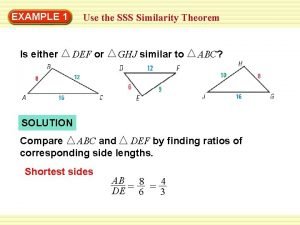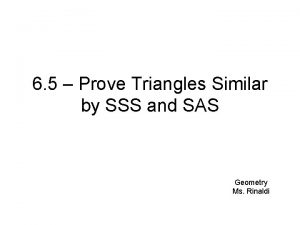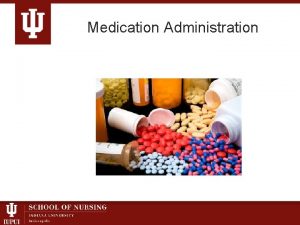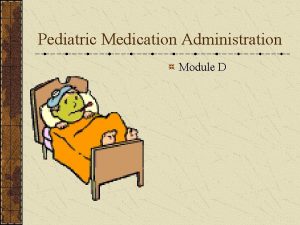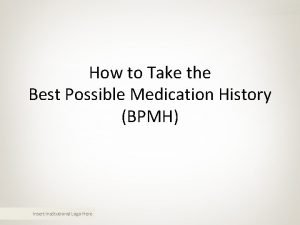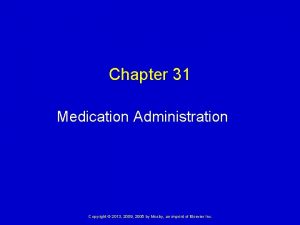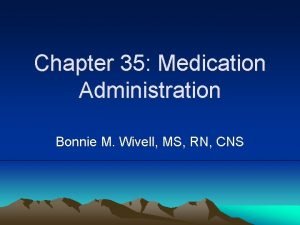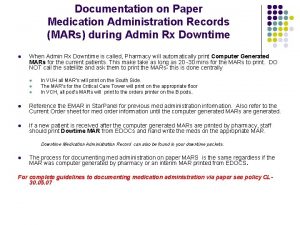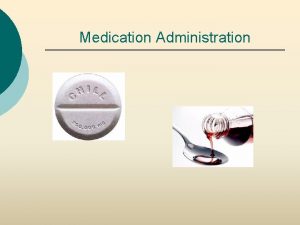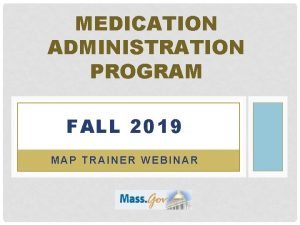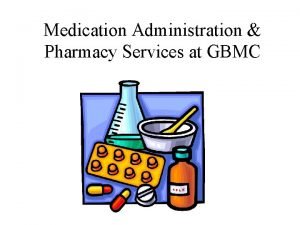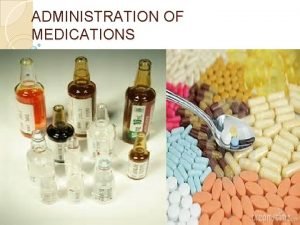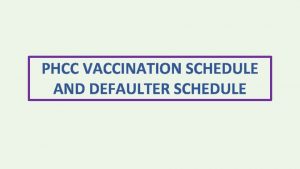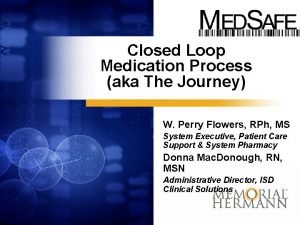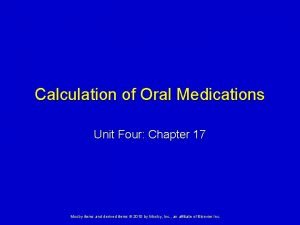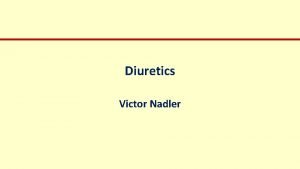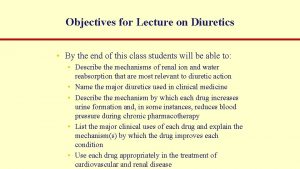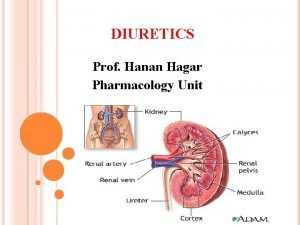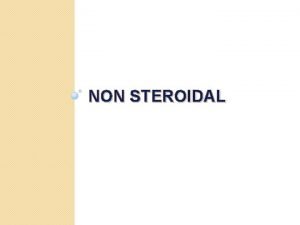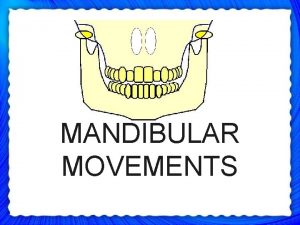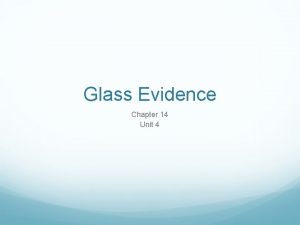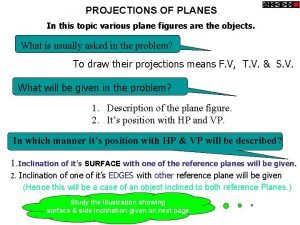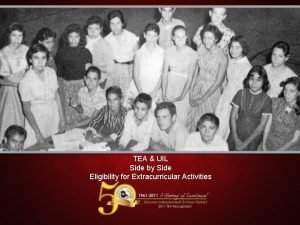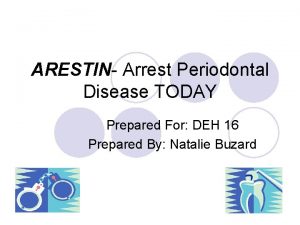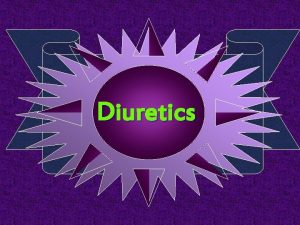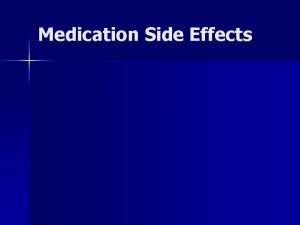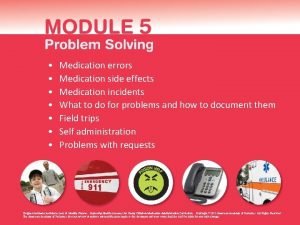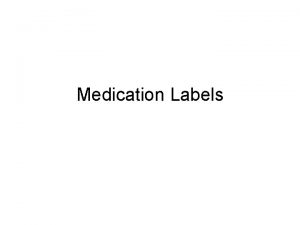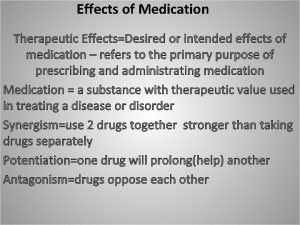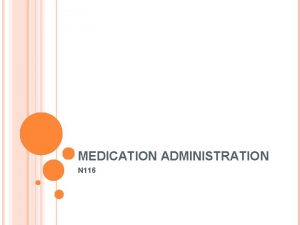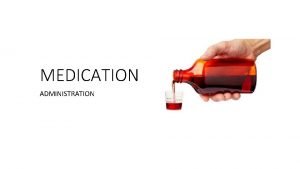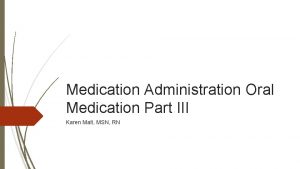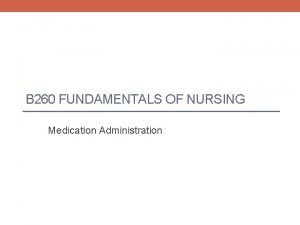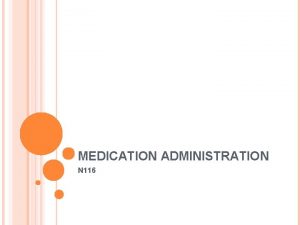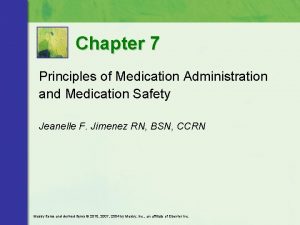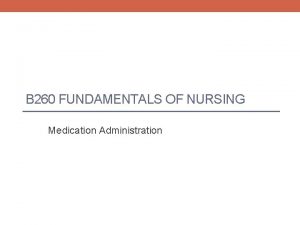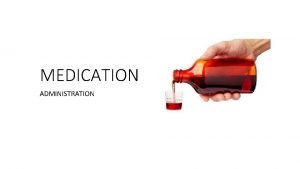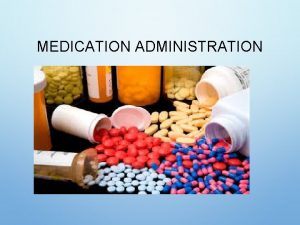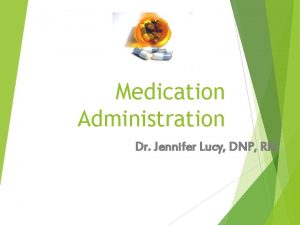Medication Administration Actions Therapeutic effects Side effects Adverse


























































- Slides: 58

Medication Administration

Actions • • Therapeutic effects Side effects Adverse effects Toxic effects Mosby items and derived items © 2005 by Mosby, Inc.

Routes of Administration • Oral: sublingual, buccal • Parenteral: intradermal, subcutaneous, intramuscular, intravenous • Topical • Inhalation • Intraocular Mosby items and derived items © 2005 by Mosby, Inc.

Classification Routes of administration can broadly be divided into: • Topical: Drugs are applied topically to the skin or mucous membranes, mainly for local action. • Oral: used for systemic (non-local) effect, substance is given via the digestive tract. • Parenteral: A drug administered parenterally is one injected via a hollow needle into the body at various sites and to varying depth. • Rectal: Drugs given through the rectum by suppositories or enema. • Inhalation: The lungs provide an excellent surface for absorption when the drug is delivered in gaseous, aerosol or ultrafine solid particle form.

Routes of administration

1 - Topical route: I Skin A-Dermal – cream, ointment (local action) B- Transdermal- absorption of drug through skin (i. e systemic action) I. stable blood levels(controlled drug delivery system) II. No first pass metabolism III. Drug must be potent or patch becomes too large II Mucosal membranes • eye drops (onto the conjunctiva) • ear drops • intranasal route (into the nose)

2 -Oral route (Cont. ) Advantages: 1 - Convenient - portable, no pain, easy to take. 2 - Cheap - no need to sterilize, compact, multi-dose bottles, automated machines produce tablets in large quantities. 3 - Variety - tablets, capsules, suspensions, mixtures.

3 - Buccal/Sublingual route: • Some drugs are taken as smaller tablets which are held in the mouth (buccal tablet) or under the tongue (sublingual tablet). • Buccal tablets are often harder tablets [4 hour disintegration time], designed to dissolve slowly. • E. g Nitroglycerin, as a softer sublingual tablet [2 min disintegration time], may be used for the rapid relief of angina.

3 - Buccal/Sublingual route (Cont. ) Disadvantages 1 - Holding the dose in the mouth is inconvenient. 2 - Small doses only can be accommodated easily.

4 - Parenteral route:

4 - Parenteral route (Cont. ) A- Intravascular (IV): - placing a drug directly into blood stream. -May be - Intravenous (into a vein) or - intraarterial (into an artery). Advantages 1 - precise, accurate and immediate onset of action, 100% bioavailability. Disadvantages 1 - risk of embolism. 2 - high concentrations attained rapidly leading to greater risk of adverse effects.

4 - Parenteral route (Cont) B-Intramuscular : (into the skeletal muscle). Advantages 1 - suitable for injection of drug in aqueous solution (rapid action) and drug in suspension or emulsion (sustained release). Disadvantages 1 - Pain at injection sites for certain drugs.

4 - Parenteral route (Cont) C- Subcutaneous (under the skin), e. g. insulin. D- Intradermal, (into the skin itself) is used for skin testing some allergens. E- Intrathecal (into the spinal canal) is most commonly used for spinal anesthesia. F- Intraperitoneal, (infusion or injection into the peritoneum) e. g. peritoneal dialysis in case of renal insuffeciency.

5 -Rectal route: Most commonly by suppository or enema. Advantages 1 - By-pass liver - Some of the veins draining the rectum lead directly to the general circulation, thus by-passing the liver. Reduced first-pass effect. 2 - Useful - This route may be most useful for patients unable to take drugs orally (unconscious patients) or with younger children. - if patient is nauseous or vomiting

5 - Rectal route (Cont. ) Disadvantages 1 - Erratic absorption - Absorption is often incomplete and erratic. 2 - Not well accepted.

6 - Inhalation route: - Used for gaseous and volatile agents and aerosols. - solids and liquids are excluded if larger than 20 micron. the particles impact in the mouth and throat. Smaller than 0. 5 micron , they aren't retained. Advantages A- Large surface area B- thin membranes separate alveoli from circulation C- high blood flow - As result of that a rapid onset of action due to rapid access to circulation.

6 - Inhalation route (Cont. ) Disadvantages 1 - Most addictive route of administration because it hits the brain so quickly. 2 - Difficulties in regulating the exact amount of dosage. 3 - Sometimes patient having difficulties in giving themselves a drug by inhaler.

Metric System • Grams (g), milligrams (mg), kilograms (kg) • Liters (L), milliliters (ml) Mosby items and derived items © 2005 by Mosby, Inc.

Household Measurements • • Tablespoons Teaspoons Ounces Cups Mosby items and derived items © 2005 by Mosby, Inc.

Prescriber’s Role • Types of orders – Single orders – Stat orders Mosby items and derived items © 2005 by Mosby, Inc.

Distribution Systems • Stock supply • Unit dose • Computer controlled Mosby items and derived items © 2005 by Mosby, Inc.

Parts of the Order • • Patient name Date and time Drug name Drug dosage • Route • Frequency • Signature

Problems with Orders • Allergies • Steps – Drug book – Pharmacist – Physician – Supervisor

Drug Administration • 3 checks – obtaining the container – removing the med – replacing the container

Nurse’s Role • Six rights • Triple-check before administration • Client assessment

Six Rights • • • Right medication Right dose Right client Right route Right time Right documentation

Client’s Rights • • Information Refusal Careful assessment Informed consent Safe administration Supportive therapy No unnecessary medications

Assessment • • • Medical history History of allergies Medication data Diet history Perceptual or coordination problems Current condition

Assessment (cont’d) • Attitude about medication use • Knowledge of therapy • Learning needs

Nursing Diagnoses • • Deficient knowledge (medications) Disturbed sensory perception Impaired swallowing Ineffective therapeutic regimen management

Planning • Goals and outcomes – Example: Client will verbalize therapeutic and adverse effects of medications • Setting priorities • Continuity of care

Implementation • Client and family teaching • Medication orders: receipt, communication • Calculation and measurement • Correct administration technique • Recording

Special Considerations • Infants and children • Older adults – Self-prescribing – Over-the-counter medications – Misuse – Noncompliance

Evaluation • Client response to medications • Client and family ability to administer medications

Oral Administration • Presence of GI alterations • Ability to swallow • Positioning

Topical Administration • Skin applications – Use of gloves or applicators – Preparation of skin – Thickness of application

Nasal Instillation • Assessment of nares • Client instruction and selfadministration • Positioning

Eye Instillation • • Drops, ointments, disks Assessment of eyes Asepsis Positioning

Ear Instillation • Assessment of ear canal • Warming of solution • Straightening of canal for children and adults • Positioning

Vaginal Instillation • Suppositories, foams, creams • Use of gloves and applicator • Client positioning, comfort, and hygiene

Rectal Instillation • Suppositories • Use of gloves • Client positioning, comfort, and hygiene

Inhalation • Metered-dose inhalers (MDIs) and dry powder inhalers (DPIs) • Client assessment and instruction • Use of spacer • Determination of doses in canister

Irrigation • Medications used to wash out a body cavity delivered with a stream of solution (sterile water, saline, or antiseptic) • Asepsis

Parenteral Administration • Equipment – Syringes: sizes (volume), types – Needles: length, gauge – Disposable units: Tubex, Carpuject – Ampules – Vials

Parenteral Administration (cont’d) • Mixing medications – Determine compatibility of the medications – Do not contaminate one medication with another – Ensure the final dose is accurate – Maintain aseptic technique

Parenteral Administration (cont’d) • Insulin – Syringes and needle sizes – Types of insulin – Mixing of insulins – Rotation of vials before withdrawal of solution

Administration of Injections • Minimize discomfort – Use smallest suitable needle – Position client comfortably – Select proper site – Divert client’s attention – Insert the needle quickly and smoothly – Hold the syringe steady – Inject the medication slowly and steadily

Administration of Injections (cont’d) • Subcutaneous injections – Sites: condition of area, rotation of use – Amount of solution – Length and gauge of needle – Pinch or spread skin – Angle of insertion

Administration of Injections (cont’d) • Intramuscular injections – Sites: landmarks, condition of area – Amount of solution – Length and gauge of needle – Angle of insertion – Aspiration – Air-lock method – Z-track technique

Administration of Injections (cont’d) • Sites – Ventrogluteal – Vastus lateralis – Deltoid

Administration of Injections (cont’d) • Intradermal injections – Skin testing – Sites – Length and gauge of needle – Angle of insertion – Formation of small bleb

Prevention of Needle Sticks • Needleless devices • Sharps disposal • One-handed recapping technique

Intravenous Administration • Large volume infusions • Bolus injection • Volume-controlled infusions – Mini-infusor pump

Avoiding Errors • • • Prepare drugs alone Don’t leave drugs alone Prepare and administer Lock med cart Supervise swallowing

Steps in Administration • • 3 checks 6 rights Assessment Patient position • Fluids • Keep meds in wrappers • Offer separately

Administering Narcotics • Definition • Record – Patient name – Amount – Time – Physician – Nurse signature – Waste/witness • Count • Discrepancies

Documentation • Legal record • When to record • Information – – med name dosage route time – – nurse initials nurse signature site of injection other information • Omitted drugs – reason – notify MD • Refused drugs 57

Medication Errors • Reasons for occurrence • Steps if error takes place
 Similar picture
Similar picture Side side side similarity
Side side side similarity Angle angle similarity theorem
Angle angle similarity theorem Sss similarity theorem
Sss similarity theorem Oral and topical medication administration posttest ati
Oral and topical medication administration posttest ati Landmark for vastus lateralis im injection
Landmark for vastus lateralis im injection Pediatric medication administration guidelines
Pediatric medication administration guidelines Macy catheter medication administration
Macy catheter medication administration Pediatric iv medication administration guidelines
Pediatric iv medication administration guidelines Closed loop medication administration safety initiative
Closed loop medication administration safety initiative Six rights of medication administration
Six rights of medication administration Concepts of medication administration posttest
Concepts of medication administration posttest Medication administration training video
Medication administration training video Himms emram
Himms emram Oral and topical medication administration pretest
Oral and topical medication administration pretest Chapter 31 medication administration
Chapter 31 medication administration Six rights of medication administration
Six rights of medication administration Electronic mars records
Electronic mars records 7 rights of medication administration in order
7 rights of medication administration in order 7 rights of medication administration in order
7 rights of medication administration in order Tmu map test
Tmu map test Intravenous medication administration pretest
Intravenous medication administration pretest Dose
Dose 8 rights of medication administration
8 rights of medication administration 10 rights of medication administration
10 rights of medication administration Medsafe houston
Medsafe houston Chapter 17 dosage calculation and medication administration
Chapter 17 dosage calculation and medication administration Acetaminophen mechanism
Acetaminophen mechanism Vildagliptin renal dose adjustment
Vildagliptin renal dose adjustment Drugs that don't cross placenta mnemonic
Drugs that don't cross placenta mnemonic Furosemide side effects
Furosemide side effects Loop diuretics adverse effects
Loop diuretics adverse effects Mannitol mechanism of action
Mannitol mechanism of action S
S Hayanil drug
Hayanil drug Single bevel weld
Single bevel weld Immediate side shift and progressive side shift
Immediate side shift and progressive side shift Glass will break first on the weaker side, the side:
Glass will break first on the weaker side, the side: A regular hexagon lamina has
A regular hexagon lamina has Side by side stuff
Side by side stuff Perfect competition side by side graphs
Perfect competition side by side graphs Videocon refrigerator temperature settings
Videocon refrigerator temperature settings Side angle side theorem
Side angle side theorem Sin inverse -1
Sin inverse -1 The incisal guidance angle varies directly with.
The incisal guidance angle varies directly with. Uil side by side
Uil side by side Red side blue side
Red side blue side Two wheels roll side by side
Two wheels roll side by side Server side scripting
Server side scripting Platzbedarf side by side melkstand
Platzbedarf side by side melkstand Sell side vs buy side
Sell side vs buy side Astemazole
Astemazole Prozac dosage chart
Prozac dosage chart Arestin side effects
Arestin side effects Hyoscyamine side effects
Hyoscyamine side effects Mirtazapine side effects
Mirtazapine side effects Side effects of diuretics
Side effects of diuretics Spironolactone side effects
Spironolactone side effects Dr wilson adrenal rebuilder side effects
Dr wilson adrenal rebuilder side effects

